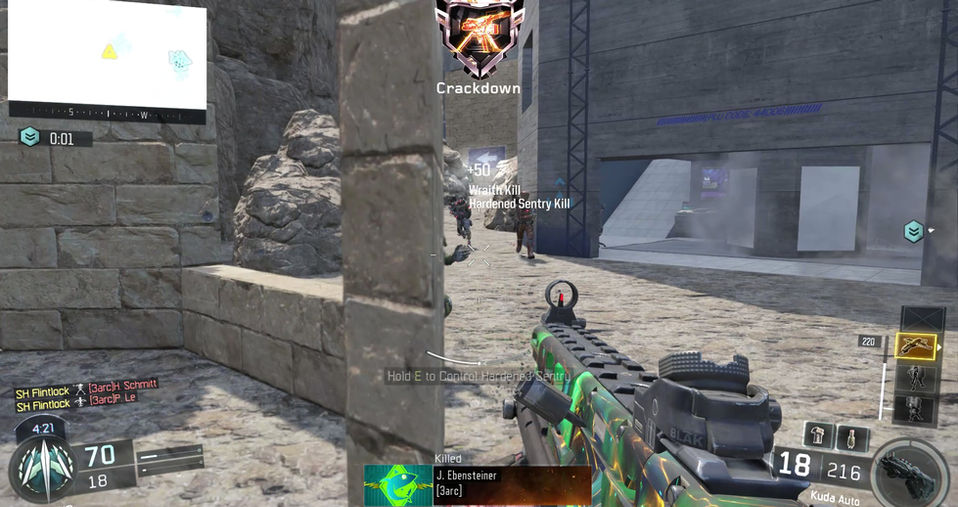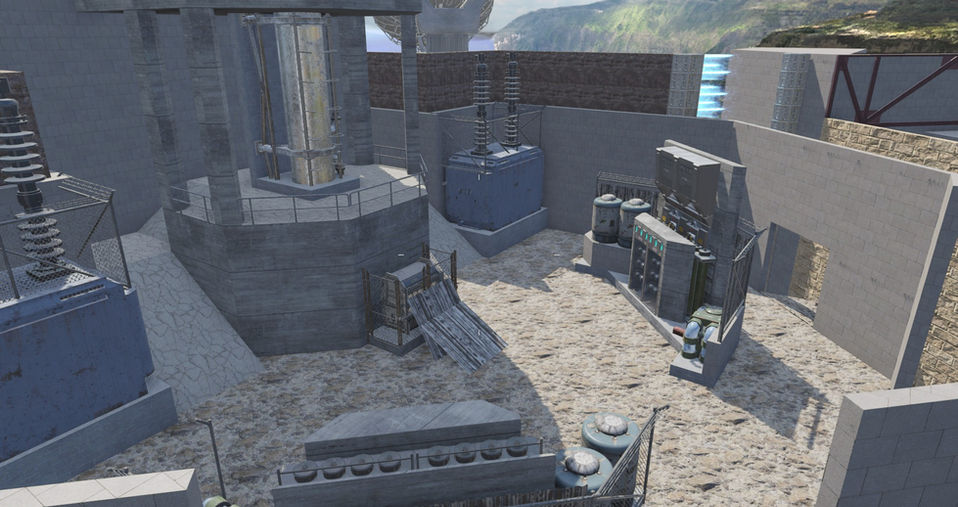
About The Level
"Signal" is a multiplayer map for Call of Duty: Black Ops 3. The level was built over 4 weeks for the Capture The Flag (CTF) game mode as well as the Hardpoint game mode. The map features a sci-fi futuristic satellite facility in the mountains. The gameplay focus is tight CQB combat, engaging mid-range firefights, a tower with strong sightlines for teams to fight over, and a large crevice to facilitate the game's unique traversal mechanics.
Design Goals
This focus of this project was about strategic gameplay zones, combat flow, movement, and conveyance. I wanted teams to fight over advantageous areas on the map while being able to move through the space in unique and strategic ways. Additionally, I wanted players to be able to easily know where they are on the map and how to get to objectives.


Strategic Gameplay
Black Ops 3 is a very high paced FPS with parkour and boost jumping elements. The level has tall corridors to allow players to wall run and jump over obstacles, and the cover is spaced out to allow players to flow around and between it quickly. I also made sure to limit potential areas where players could get stuck by limiting angles greater than 45 degrees.
Combat Flow
The center area of the map is comprised of mid-large size areas with a heavy combat focus. The edges of the map are filled with smaller corridors, or membranes, that allow the player to flank enemy positions, recover from high intensity combat, and reload/switch weapons in a safer environment. This facilitates a balance of high and low intensity encounters.


Movement
The map is intentionally designed to be asymmetrical, but with sides that parody each other. Lots of balancing had to be done to facilitate objective based game modes such as distance from spawns to objectives, time to reach the upper floor from spawn, cover placement / concentration, and advantageous sightlines. Both spawns can reach the second floor in 7 seconds, and reach each bomb site in 12 seconds.
Conveyance
The center area of the map is comprised of mid-large size areas with a heavy combat focus. The edges of the map are filled with smaller corridors, or membranes, that allow the player to flank enemy positions, recover from high intensity combat, and reload/switch weapons in a safer environment. This facilitates a balance of high and low intensity encounters.

Maps and Planning
Overview Map (Floor 1)

Legend

Overview Map (Floor 2)

Maps and Planning
Blockout (Greybox)



Design Process
The focus of this map design was movement. I wanted to build a space that fostered Black Ops 3's unique movement system. To do this, I divided the map into 3 "islands" wit a large crevice running between each section. Once I had a solid map design I started to block it out in engine. During this stage, I also set up the spawns and objectives so the map would be playable.
After several tweaks and iterations based on feedback, I finalized my layout and started adding cover and set dressing. I added color schemes to the two spawn sides of the map for conveyance, and gave each area a distinct style so players could memorize the map and know where they are.
Finally, once gameplay was feeling good, I did an aesthetics pass and finalized the AI navigation and air support scripting. Once things looked good and all the systems were polished, I published the map.
Postmortem
Went Well
Went Wrong
What I Learned
-
Planning. I spent a fair amount of time planning out the level, researching the engine, and gathering resources. Because of this, I was able to hit the ground running with a clear end goal and prototype quickly.
-
Adjusting Scope. The level was initially over scoped, but through careful cutting and communication with stakeholders, peers, and industry pros, I was able to get back in scope and get on track.
-
Feedback. I sought feedback constantly through this project, as I would have less time to iterate than other projects. I had peers, pros, and stakeholders playtest constantly and iterated based on feedback nearly every day.
-
New Editor. Learning Radiant was a challenge and cost some time early on. There are many quirks that have very little documentation, and ironing these out was difficult. I was able to find many resources to help including an online modding community and a contact at Treyarch to help me solve problems and stay on track.
-
Timeline. This project was given half the traditional timeline for projects in this course, and so time management became a huge priority. Though the deadlines were fast and I had less milestones, I was able to keep a steady pace and finish everything on time.
-
Connections. Finding experienced people and quality resources is critical when starting a project in a new engine. Though I had gathered many tutorial resources before the project began, I now know how beneficial it can be to have personal contacts with individuals who can give directed feedback and assistance.
-
MP Balancing. A lot goes into balancing a multiplayer FPS level, and I now have a good idea about how to take each component and see how they all work together. Things such as sightlines, lanes, cover, and verticality all affect each other and understanding that balance will be a huge asset in future projects.
Gallery


























